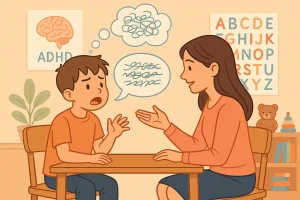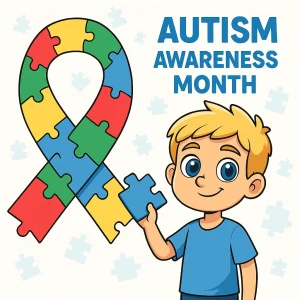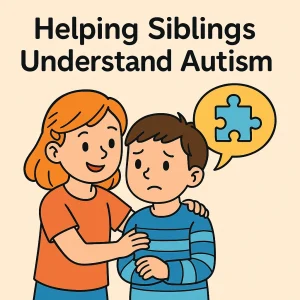How Therapists Can Spot and Address Virtual Autism
Last Updated: September 23, 2024
In today’s digital age, children are growing up surrounded by screens—from smartphones and tablets to computers and TVs. While technology can be a wonderful tool for learning and entertainment, excessive screen time may have unexpected consequences, including a condition referred to as “virtual autism.” Virtual autism describes autism-like behaviors that arise from prolonged exposure to digital devices, and it’s becoming increasingly relevant as more children spend hours each day in front of screens.
For educators, spotting and addressing virtual autism is crucial. You, as a teacher, play a pivotal role in noticing early signs of developmental delays that may be linked to screen time. Since you interact with students on a daily basis, you are often the first to recognize when something is off. Early intervention—especially in a classroom setting—can make all the difference in helping children overcome challenges and thrive academically and socially.
Read More: Virtual Autism: Things that you need to know
What Is Virtual Autism?
Virtual autism is a term used to describe autism-like behaviors in children that are linked to excessive screen time. Unlike traditional Autism Spectrum Disorder (ASD), which is a neurodevelopmental condition often present from birth, virtual autism refers to developmental delays or challenges that may arise due to prolonged exposure to digital devices, such as tablets, smartphones, and televisions. In essence, it highlights the growing concern of how too much screen time could interfere with a child’s cognitive and social development.

But how does this happen? When young children spend an excessive amount of time in front of screens, they miss out on essential face-to-face interactions, sensory experiences, and physical activities. These real-world interactions are critical for the brain to develop key skills like language, social cues, and attention regulation. Without these, children may show signs of virtual autism, such as delayed speech, difficulty in making eye contact, and repetitive behaviors.
Read More: Understanding Virtual Autism: Impact of Screen Time
Key Differences Between Virtual Autism and Traditional Autism
| Aspect | Virtual Autism | Traditional Autism |
|---|---|---|
| Causes | Virtual autism is linked to excessive screen time exposure, especially during the critical developmental years. It typically results from a lack of real-world interactions due to over-reliance on digital devices. | Traditional autism, also known as Autism Spectrum Disorder (ASD), is a neurodevelopmental condition that is usually present from birth. It has no single cause and is thought to be linked to genetics and brain development. |
| Symptoms | Children with virtual autism may show speech delays, trouble focusing, difficulty with eye contact, and challenges in social interactions. These symptoms arise primarily due to limited face-to-face interaction and excessive screen use. | Children with traditional autism often exhibit similar symptoms—such as delayed speech, challenges with social interactions, and repetitive behaviors—but these symptoms are more deeply rooted and persist throughout life. |
| Reversibility | Virtual autism is often reversible. When screen time is significantly reduced and children are engaged in more real-world social, physical, and interactive activities, many of the symptoms improve or disappear entirely. | Traditional autism requires lifelong support. Although some symptoms can improve with therapy and intervention, autism is not “reversible.” Individuals may require ongoing support in education, social skills, and communication. |
| Intervention | Intervention for virtual autism involves limiting screen time, increasing face-to-face interactions, encouraging playtime, outdoor activities, and hands-on learning to promote development. | Traditional autism interventions are more complex, requiring specialized therapies such as behavioral therapy, speech therapy, and educational support tailored to the individual’s specific needs. |
| Long-term Impact | Children with virtual autism can show significant improvement with early intervention and lifestyle changes. They can catch up on social, speech, and cognitive skills when the right steps are taken early. | While early intervention also helps children with traditional autism, the condition is typically a lifelong developmental disorder that requires ongoing, specialized support to improve quality of life and independence. |
The Role of Educators in Identifying Virtual Autism
As an educator, you are in a unique position to observe behaviors that might otherwise go unnoticed. Virtual autism can present subtle signs, but with a focused approach, you can play a key role in early detection and support for students.
1. Observing and Documenting Behaviors: What to Look for During Class Time
In the classroom, it’s essential to observe students closely. Look for patterns that suggest a child may be struggling with attention, social interactions, or language development. A student who consistently avoids eye contact, becomes overly attached to a device, or has difficulty following instructions could be displaying early signs of virtual autism.
Document these behaviors carefully. Keeping a record of when and how often these behaviors occur will give you a clearer picture of whether there is cause for concern. This documentation can also serve as valuable evidence if you need to discuss the child’s development with parents or other professionals.
2. Engaging with Parents: Understanding Home Environments and Screen Usage
Open communication with parents is essential when identifying virtual autism. Parents may not always be aware of how much screen time their child is exposed to or how it affects them. By asking about the child’s screen usage at home, you can gain a better understanding of their environment and provide advice on managing it.
Approach this conversation with empathy. Many parents may not realize the potential harm of too much screen time, so framing your concerns in a helpful and supportive way is key. Suggest ways they can balance screen time with other activities, like outdoor play, reading, or family interactions.
3. Collaborating with School Psychologists or Counselors for Further Evaluation
As a teacher, you don’t have to handle everything alone. If you suspect a student is showing signs of virtual autism, it’s important to collaborate with school psychologists or counselors. These professionals can conduct more in-depth evaluations and help determine whether the child needs additional support or intervention.
By working together, educators and school staff can create a comprehensive support plan for the student, addressing both the academic and developmental challenges associated with virtual autism.
4. Encouraging a Balanced Approach to Screen Time
One of the most effective ways educators can help students avoid virtual autism is by promoting a balanced approach to screen time. In the classroom, this could mean incorporating more interactive, hands-on activities that pull students away from screens and encourage social interaction. You can also talk to parents about the importance of setting screen limits at home.
Encourage students to engage in physical activities, group projects, or even mindfulness exercises. These activities not only reduce the reliance on screens but also help in developing essential skills like communication, focus, and teamwork.
Addressing Virtual Autism in the Classroom
When a student shows signs of virtual autism, there are ways to help them in the classroom. Teachers can play a big role in reducing screen time and encouraging activities that help students engage with others and learn better. Here are some simple strategies to address virtual autism.
1. Strategies for Reducing Screen Time and Promoting Interactive Activities
- Encouraging Face-to-Face Interactions
Create chances for students to talk and work together. Group projects, class discussions, and presentations help kids interact with each other, which is important for building social skills. These activities reduce the reliance on screens and make learning more engaging. - Using Hands-On Learning
Activities that involve real-world experiences, like science experiments, art projects, or building models, are great for engaging students. These hands-on activities make learning fun and help students develop important skills like critical thinking and problem-solving, which screens don’t provide. - Incorporating Physical Activities
Physical activities can help students stay focused and improve attention spans. Simple exercises, short movement breaks, or even adding physical elements to lessons can make a big difference. A quick stretch or short walk between lessons can help students reset and focus better.
2. Supporting Children with Virtual Autism
- Tailoring the Learning Environment
Every student is different, so it’s important to create a learning environment that works for them. Some kids may need quiet spaces to concentrate, while others might do better in group activities. Being flexible with your teaching methods helps students feel more comfortable. - Using Positive Reinforcement and Routines
Positive feedback, like praising students for their efforts, encourages them to keep trying. Structured routines are also helpful, as they give students a sense of stability and predictability. Having set times for activities like group work, independent tasks, and physical activities can help students feel secure and engaged.
Partnering with Parents and Caregivers
Teachers can’t address virtual autism on their own—it’s important to work together with parents and caregivers. By partnering up, both home and school can provide consistent support for the child. Here are some simple ways teachers can help parents reduce screen time and support their child’s development.
Educating Parents on the Risks of Excessive Screen Time
Many parents may not realize the full impact of too much screen time on their child’s growth. As a teacher, you can help by explaining how too much time on screens can affect speech, social skills, and attention. Use simple language and give everyday examples to make the risks clear.
For example, explain how cutting back on screen time can lead to more meaningful family interactions, which helps develop communication skills. You can also share studies that show how screen time can affect a child’s thinking and emotions.
Sharing Resources and Strategies for Reducing Screen Time at Home
Parents often find it hard to manage their child’s screen use. As an educator, you can suggest some practical ways to help:
- Set screen time limits: Encourage parents to set rules for when and how long screens can be used, like no screens during meals or before bed.
- Suggest alternatives: Recommend activities that keep kids away from screens, such as reading, outdoor play, or arts and crafts.
- Model good behavior: Remind parents that children often copy their behavior, so limiting their own screen use around kids sets a good example.
How Teachers and Parents Can Work Together
It’s important for teachers and parents to work as a team to help the child. When both home and school work together, the child is more likely to succeed. Here are some ways to make sure this partnership works:
- Communicate regularly: Keep in touch with parents, whether through quick chats, emails, or phone calls. Sharing updates helps keep everyone on the same page.
- Set shared goals: Work with parents to set goals like reducing screen time and increasing face-to-face activities. This way, the child gets the same message at home and school.
- Share feedback: Ask parents to share what they notice at home and give them feedback on what you see in class. This will help you both adjust and stay on track.
By working closely with parents and caregivers, teachers can create a stronger support system for the child. This teamwork can make a big difference in helping children reduce screen time and thrive in their development.
The Importance of Early Intervention

Early intervention is crucial for addressing virtual autism. The sooner the signs are noticed, the easier it is to help children overcome developmental delays linked to too much screen time. By reducing screen use early and encouraging more hands-on activities, teachers and parents can help children get back on track in their learning and social skills.
1. Why Early Identification of Virtual Autism Is Important
Catching the signs of virtual autism early allows teachers and parents to act before delays become more serious. Since virtual autism is linked to screen use, early changes—like cutting down on screen time and adding more face-to-face interactions—can help children develop better language, focus, and social skills. The earlier these changes are made, the better the results.
2. Examples of How Early Intervention Helps
There are many success stories where early intervention has made a big difference. For example, one 4-year-old who was spending too much time on screens had trouble speaking and playing with others. After their screen time was reduced and more social activities were introduced, their speech improved, and they started interacting more with classmates.
In another case, a child who couldn’t focus in class saw great improvement after their parents reduced screen time and encouraged outdoor play. Within a few months, the child’s attention and ability to follow instructions improved significantly.
3. Long-Term Benefits of Early Intervention
Helping children early on can lead to lasting improvements in their academic and social success. Kids who receive support early are more likely to do well in school, make friends, and communicate better. Without early help, children might continue to struggle with speech, social skills, and focusing in class. Early intervention sets them up for long-term success both in school and in life.
Conclusion
Educators play an important role in spotting and addressing virtual autism in children. By watching for early signs, promoting healthier screen habits, and working with parents, teachers can help make a big difference in a child’s development. Early intervention is key, and as a teacher, you are in a unique position to notice these signs and take action.
It’s also important to stay informed and be proactive in reducing screen time for students. The actions you take now can have a positive impact on a child’s future academic and social success. If you’re looking for more support and resources, Wellness Hub provides valuable tools to help guide you in supporting children with developmental challenges.
Frequently Asked Questions:
1. What is virtual autism?
Virtual autism refers to autism-like symptoms in children that may develop due to excessive screen time. These symptoms can include delayed speech, poor social interaction, and difficulty focusing, but can often be improved by reducing screen exposure.
2. How can teachers identify signs of virtual autism?
Teachers can spot signs of virtual autism by observing behaviors such as delayed speech, trouble making eye contact, strong attachment to screens, repetitive actions, and difficulty following instructions. These signs often appear in classroom settings where face-to-face interactions are needed.
3. Can virtual autism be reversed?
Yes, virtual autism symptoms can often be improved with early intervention. By reducing screen time and increasing real-world, hands-on activities, children can overcome developmental delays caused by too much screen exposure.
4. How does virtual autism differ from traditional autism?
Unlike traditional autism, which is a neurodevelopmental disorder often present from birth, virtual autism is thought to be triggered by excessive screen time. It can be reversible with proper intervention, whereas traditional autism requires ongoing support.
5. What role do educators play in addressing virtual autism?
Educators play a crucial role in identifying early signs of virtual autism and working with parents to reduce screen time. Teachers can create engaging, hands-on learning activities and promote social interactions that help children develop better communication and attention skills.
6. How can parents and teachers work together to reduce virtual autism symptoms?
Teachers and parents should maintain regular communication to set consistent goals, such as reducing screen time both at home and at school. By working together, they can provide a balanced approach that includes outdoor play, hands-on activities, and limited screen exposure.
7. Why is early intervention important for virtual autism?
Early intervention helps to reverse the developmental delays caused by excessive screen time. The sooner signs of virtual autism are addressed, the better the chance for children to improve their speech, social skills, and attention spans, leading to long-term academic and social success.
8. How can reducing screen time help children with virtual autism?
Reducing screen time allows children to engage more in real-world activities that promote language development, social skills, and attention. Activities like outdoor play, reading, and interactive learning can significantly improve symptoms of virtual autism.
9. What are some classroom strategies to help children with virtual autism?
Teachers can implement strategies such as hands-on learning, physical activities, and face-to-face group work to help children engage more with the real world. These activities promote social interaction and reduce reliance on screens.
10. Where can I find resources to help children with virtual autism?
Wellness Hub provides valuable resources and tools for educators and parents to support children with developmental challenges, including virtual autism. Visit Wellness Hub for more guidance on addressing virtual autism in the classroom and at home.
About the Author:
Anuradha Karanam
Speech-language pathologist (7+ years of experience)
Anuradha Karanam is a skilled speech-language pathologist with over 6 years of experience. Fluent in Tamil, Telugu, Hindi, and English, she specializes in parent counseling, speech sound disorders, fluency assessment, and speech-language evaluations. Anuradha excels at working with children with developmental disorders, offering creative and effective therapy programs. Currently, at Wellness Hub, she holds a BASLP degree and is registered with the RCI (CRR No A85500). Her patience, ambition, and dedication make her a trusted expert in her field.
Book your Free Consultation Today
Parent/Caregiver Info:
Client’s Details:
* Error Message









